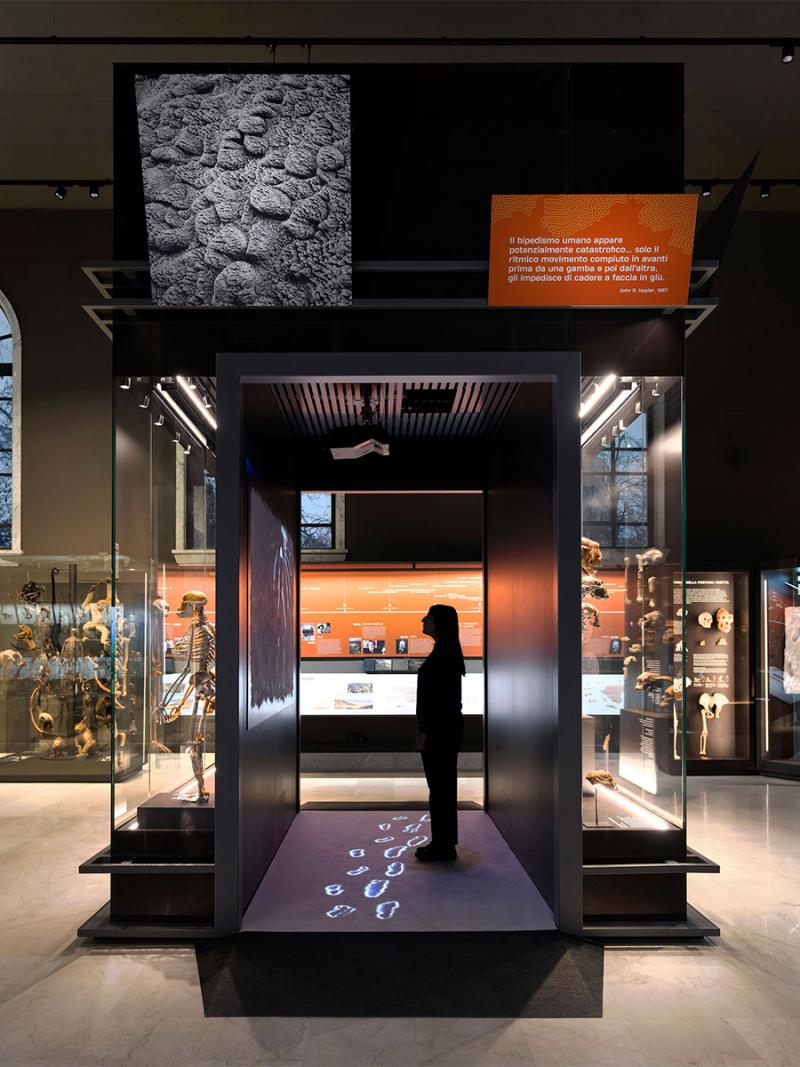The Migliore+Servetto design studio has created the permanent design for Room IX of the Natural History Museum of Milan, dedicated to the “natural history of humans.” The intervention involves more than 4,305 square feet and ranges from the overall conception of the room layout—also in terms of the planes and spaces of the environmental graphic communication and multimedia—to the design of the installations that will lead to the reopening of the room to the public, starting from the end of 2023, one year after its closure.
The exhibition concept, which was designed for the human evolution room (Room IX), is just the first step of the renovation process put into place by the museum and has been conceived so that it can be included in and adapted to all the other rooms.
The Natural History Museum of Milan consists of more than 700 display cases divided into 23 rooms, housed in a Neo-Gothic style building within the Public Gardens of Porta Venezia. The design of the room’s new layout, which includes different exhibition typologies, reflects the curatorial subdivision of the space into four macro areas in ways that are immediately understandable, with every area distinguished by a specific color and out of scale visual and numerical signage.
A scenic tower stands out in the middle of each area as the core of the installation: a nearly 15-foot-high parallelepiped made of glass is conceived as the setting of a narration that spans the physical and the digital, both in the interior and exterior spaces. The first tower acts as a huge display case, within which skeletons of current primates are exhibited. The second one can be crossed through and invites visitors to enter and immerse themselves in the multimedia scenography. The third one has an entrance that opens up the view over the inner environment, which is arranged to build an immersive form of storytelling recounting how the ancient representatives of the Homo genus left Africa.

The last one, which also can be crossed through like the second one, is dedicated to thought and creativity and is next to a special purpose-built display case that hosts the monumental remains of prehistoric animals.
Five eight-foot-high free-standing display cabinets are arranged alongside the four towers. Conceived as narrative open chests they are placed upright and, inside them, the installation explores themes concerning the section in which they are located. In addition, there are five display cases in the room divided in two typologies: Tables and towers. Thanks to imperceptible lamps mounted on both longitudinal sides, it was possible to set up both the models from the inside. This device was designed to facilitate further updates and changes to the contents on display quickly and easily, to fulfill the ever-changing exhibition needs. To give continuity to the storytelling, which is divided into four moments, the Migliore+Servetto design studio has placed a double inclined plane on both longitudinal sides of the room. One plane for each section hosts the timeline that accompanies the public during the visit by contextualizing the storytelling temporally.
Two graphic walls are placed at the entrance and the exit of the Room, acting as two narrative planes that remind visitors of the complex themes on display. A lateral, fixed-angle terrace completes the installation, offering an overview of the room to those sitting there. It was conceived to host groups and offer a starting point for visits for the guides, who can explain and introduce the complicated issues of the upcoming sections in this place.
Migliore+Servetto also curated the lighting design, in which light and shadow are conceived as two dialectic elements that permeate the environment to build pathways and trace accents, defining the visit and reading pace. Lastly, the project also envisages an environmental sound diffusion to accompany the visit.
Related Stories
Now Open: Palazzo Cordusio Gran Meliá
Tourist Italy Launches New Tours for Spring 2024
Hotel Calimala in Florence Introduces “Calimala The West”
Central Holidays Unveils New Family-Friendly Italy Itinerary